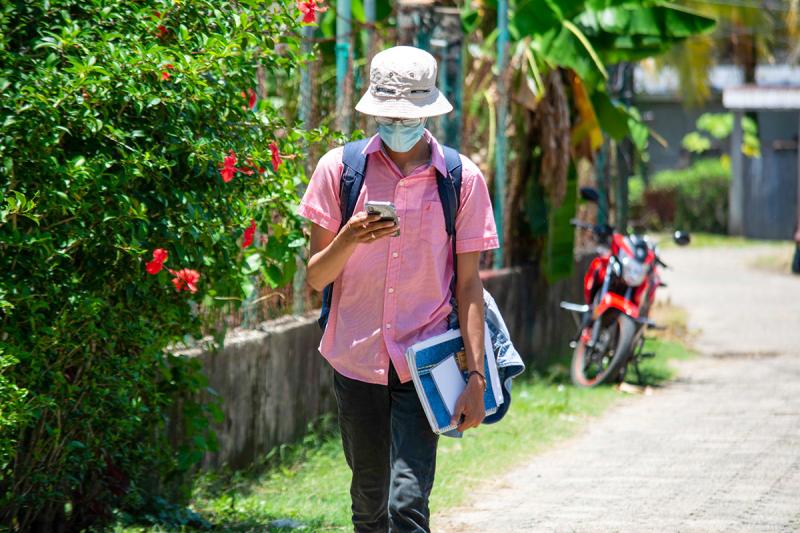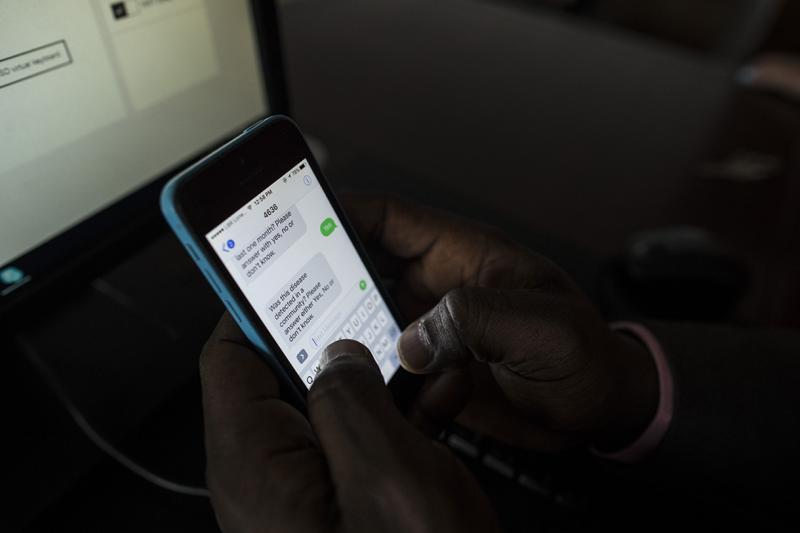Where We Work
See our interactive map


A health worker checks their phone on the way to visit HIV-positive clients in Livingston Izabal, Guatemala. Photo by Levi Dieguez for IntraHealth International.
Interoperability. Now we're syncing data from the communication tool with even more health information systems to combat COVID-19.
When Ebola spread through Liberia in August 2014, health workers needed information—and they needed it fast. We’ve seen exactly the same need during the COVID-19 pandemic.
Back in 2014, IntraHealth International and UNICEF created mHero—a two-way, mobile phone-based communication system that connects ministries of health and frontline health workers—to support health-sector communication in Liberia during the Ebola outbreak.
The original version connected Liberia's health workforce information system, iHRIS, with RapidPro, a platform that delivers basic text and audio messages. Linking the two information systems made it easier to reach most Liberian frontline health workers who were using basic mobile phones.
mHero distinguished itself from other digital health platforms by not being just another technology.
Today mHero is a vital communication tool and health worker registry platform—for COVID-19 and other urgent health needs—that countries around the world are using to:
mHero’s primary function and feature is interoperability. Since it was first developed, mHero distinguished itself from other digital health platforms by not being just another technology, but rather a tool that integrates and leverages existing systems, platforms, and data.
Advancements in technology and the individual needs of our partner countries inspired IntraHealth to make mHero interoperable with even more information systems.
mHero can now operate with any health information systems compliant with the global Fast Healthcare Interoperability Resource (FHIR) standards —the framework for sharing, integrating, and retrieving clinical health data and other electronic health information. Now our team is exploring how to convert information collected via mHero into standard FHIR formats. This would mean information collected via mHero could be used in other health information systems, which would make it more useful for health workers and ministries of health, providing government officials with more data to inform their analysis and decision-making as they respond to COVID-19 and future health threats.
A message from mHero appears on a health worker's phone. Photo by Sarah Grile for IntraHealth International.
We asked ourselves: How can we change mHero and FHIR tools so that health workers and ministries of health can sync and share data about the COVID-19 response? We identified some exciting possibilities.
For example, a health worker at a health facility may need to report daily on the number of staff and patients who received COVID-19 vaccinations. So we determined which elements of those data should be synced and/or shared (such as the facility’s location and client data) and outlined the message flow—that is, the messages that ministry officials and health workers might send back and forth to each other to report and collect information about vaccinations using mHero.
And then we did it for other common COVID-19 reporting scenarios a health worker might be part of using the World Health Organization’s guidelines—global parameters that allow message flows to be used widely.
Health officials at different levels of the health system can have access to more complete information.
We found that health worker contact information, information about the facility and its location, plus the data about staff and clients are data elements that may want to be synced. mHero has been able to sync contacts in messaging platforms with FHIR—which already harmonizes contact information and identifies that health worker submitting the data—but now it can also provide more structure for the data, providing context and therefore, more useful information.
We further expanded mHero’s conversion capabilities by developing a tool that can convert message flows developed in RapidPro or other compatible messaging platforms into FHIR resources so the responses to message flows can also be converted.
So now, the vaccine data submitted by health workers, for example, can be automatically synced with health information software like DHIS2 and OpenLMIS. This means health officials at different levels of the health system can have access to more complete information that previously would have been stored in separate systems. This could help countries keep track of vaccination rates, determine where demand is high (or low), and make sure health facilities have access to sufficient vaccines, PPE, and other supplies to meet demand.
Building sample message flows and outlining the methodology for converting, syncing, and extracting data elements represents a major advancement in the global understanding of what is possible with SMS messaging and FHIR and helps us narrow down the best approach for each channel used to capture data. This work is helping us expand what can be done when more health information systems are based on FHIR.
And while short messaging like SMS and WhatsApp are still the most prevalent channels for communication around the world, the ability to convert data collected via SMS—a very basic and widely accessible channel—into a format that can be synced with many different systems opens up the possibilities for collecting information from rural areas. This could provide a real-time understanding of the conditions everywhere and inform decision making that provides essential support and resources where needed.
The development and testing of FHIR-compliant COVID-19 workflows with mHero were funded by Digital Square and supported by members of several global digital health communities including OpenHIE (specifically the OpenHIE COVID-19 Task Force), the World Health Organization, Global Goods, CDC, and HL7.
Digital Square is a PATH-led initiative funded and designed by the United States Agency for International Development, the Bill & Melinda Gates Foundation, and a consortium of other donors.
Get the latest updates from the blog and eNews




